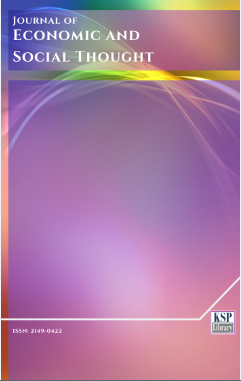Agri-food implications of Fukushima nuclear disaster: 10 years later
Abstract
Abstract. On March 11, 2011, the strongest ever recorded in Japan earthquake occurred which triggered a powerful tsunami and caused a nuclear accident in Fukushima nuclear plant. The latter was a “manmade” disaster having immense impacts on people’s life, health, and property, infrastructure, supply chains, economy, policies, natural and institutional environment, etc. This paper presents work in progress and assesses preparedness for and agri-food impacts of the Fukushima nuclear disaster, identifies challenges in post-disaster recovery, and withdraws lessons for improving disaster risk management. Japan was not well prepared for such a huge disaster while the agri-food sector and consumption have been among the worst-hit areas. The triple disaster was a rare but high-impact event, therefore, it is necessary to “prepare for the unexpected”. Risk assessment is to include diverse hazards and multiple effects of a likely disaster, it is to be discussed with all stakeholders, and measures taken to educate and train all for complex disasters. It is necessary to modernize property rights, regulations, safety standards, and norms, enhance the capability of responsible public authorities and improve coordination between diverse actors. It is important to set up mechanisms for effective public resource allocation and reduction of agents’ costs. Different elements of the agri-food chain have dissimilar capabilities requiring differential public support. There is a strong “regional” interdependency of agrarian, food, and rural assets (and damages), and it is important to properly locate risk and take prevention and recovery measures. Disaster response demonstrated the important role of small-scale farms and food organizations, and the high efficiency of private, market, and collective governance. Before, during, and after a disaster, all available information from all sources is to be immediately publicized in understandable form through all possible means. Disaster provides an opportunity to discuss, introduce and implement fundamental changes in agricultural, economic, regional, energy, disaster management, etc. policies. It is important to learn from past experiences, prepare for multiple disasters, and make sure that “lessons learned” are not forgotten.
Keywords. Agri-food, Fukushima nuclear disaster.
JEL. Q10, O31, O33, Q01, Q16, Q18.Keywords
References
Bachev, H. (2014). Socio-economic and environmental impacts of March 2011 earthquake, tsunami and Fukushima nuclear accident in Japan, Journal of Environmental Management and Tourism, 5(2), 127-222.
Bachev, H. (2019). Assessment of Preparedness and Agri-Food Impacts of Fukushima Nuclear Accident: Implications for Improvement of Disaster Risk Management, in Leif Inge Magnussen (Editor) Disaster, Diversity and Emergency Preparation, IOS Press.
Bachev, H. & Ito, F. (2014). Implications of Fukushima nuclear disaster for Japanese agri-food chains, International Journal of Food and Agricultural Economics, 2(1), 95-120.
Bachev, H., & Ito, F. (2018). Agricultural Impact of Great East Japan Earthquake, KSP Books: Istanbul.
Brasor P., & Tsubuku, F. (2018). Tepco's compensation for 3/11 victims made matters worse, National, April 13, 2018.
FAO/IAEA, (2018). Nuclear Emergency Response for Food and Agriculture, FAO/IAEA.
FPG, (2021). Station, Fukushima Prefectural Government.
Hamada, N., & Ogino, H. (2013). Earthquake food safety regulations: what we learned from Fukushima nuclear accident, Journal of Environmental Radioactivity, 111, 83–99. doi. 10.1016/j.jenvrad.2011.08.008
JFC, (2014) Findings on Impact of Earthquake on Food Industry, Farm Management and Purchasing Behavior of Consumers, Japan Finance Corporation, Tokyo.
Johnson, R. (2011). Japan’s 2011 Earthquake and Tsunami: Food and Agriculture Implications, Congressional Research Service, Washington DC.
Kunii, N., Fujimura, M., Komasa, Y., Kitamura, A., Sato, H., Takatsuji, T., Jimba, M., & Kimura, S. (2018). Knowledge and awareness for radiocesium food monitoring after Fukushima nuclear accident, Internatioanl Journal Environmental Research Public Health, 15(10), 2289. doi. 10.3390/ijerph15102289
Koyama, R. (2013). Influence and damage by nuclear disaster on Fukushima’s agriculture, Commercial Studies, 4, 15-25.
MAFF, (2021). Annual Report, Ministry of Agriculture, Forestry, Fisheries, Tokyo.
MECSST, (2011). Land Contamination, Ministry of Education, Culture, Sports, Science, Technology.
ME, (2021). Environmental Remediation in Japan, Ministry of Environment, Tokyo.
MHLW, (2020). Survey of Dietary Intake of Radionuclides, Ministry of Health, Labor, Welfare, Tokyo.
Monma, T., Goto, I., Hayashi, T., Tachiya, H., & Ohsawa, K. (2015). Agricultural and Forestry Reconstruction After Great East Japan Earthquake, Springer.
Nakanishi, T., & Tanoi, K. (2013). Agricultural Implications of Fukushima Nuclear Accident, Springer.
Nakanishi, T. (2018) Agricultural aspects of radiocontamination induced by Fukushima accident, Proc. Jpn. Acad., 94(1), 20-34. doi. 10.2183/pjab.94.002
NRA, (2021). Monitoring info of environmental radioactivity, Nuclear Regulation Authority, Tokyo.
Oka, T. (2012). Application of cost-benefit analysis to regulation of foodstuffs contaminated with radioactive substances, Japan Journal of Health Physics, 47(3), 181-188. doi. 10.5453/jhps.47.181
Osawa, M., & Ujiie, K. (2016). Changes in consumer leafy vegetable consumption behavior after the nuclear accident, Food System Research, 23(3), 213-218.
Sekizawa, J. (2013). Appropriate risk governance on radionuclide contamination in food in Japan, issues learned from 3.11 disaster, Society for Risk Analysis, 54(2), 31-35. doi. 10.3358/shokueishi.54.89
RA, (2021). Progress to date, Reconstruction Agency, Tokyo.
Takebayashi, Y., Murakami, M., & Nomura, S. (2020). The trajectories of local food avoidance after FDNPD, International Journal of Disaster Risk Reduction, 46, 101513. doi. 10.1016/j.ijdrr.2020.101513
Todo, Y., Nakajima, K., & Matous, P. (2015). How do supply chain networks affect resilience of firms to natural disasters? Journal of Regional Science, 55(2), 209–229. doi. 10.1111/jors.12119
Ujiie, K. (2012). Consumer’s evaluation on radioactive contamination of agricultural products in Japan, Food Syst Res, 19, 142-155. doi. 10.1007/978-4-431-55828-6_18
Watanabe, N. (2013). Current State of Losses from Nuclear Accident and Support Measures by JA, Norinchikin Research Institute, Tokyo.
WHO, (2013). Health risk Assessment from Nuclear Accident after Great East Japan Earthquake, World Health Organization, Genève.
DOI: http://dx.doi.org/10.1453/jest.v8i3.2233
Refbacks
- There are currently no refbacks.
Journal of Economic and Social Thought - J. Econ. Soc. Thoug. - JEST - www.kspjournals.org
ISSN: 2149-0422
Editor: [email protected] Secretarial: [email protected] Istanbul - Turkey.
Copyright © KSP Library




